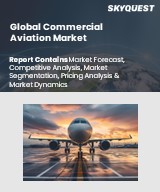
Report ID: SQMIG20S2017

Report ID:
SQMIG20S2017 |
Region:
Global |
Published Date: July, 2024
Pages:
202
|
Tables:
89 |
Figures:
68
Commercial Aviation Market size was valued at USD 190.29 Billion in 2023 and is poised to grow from USD 198.72 Billion in 2024 to USD 281.09 Billion by 2032, growing at a CAGR of 4.43% during the forecast period (2025-2032).
The growth of the commercial aviation market is propelled by several factors. Firstly, the increasing global population and rising middle-class incomes, especially in emerging economies, have led to a surge in air travel demand. This is further supported by the growing propensity for travel, driven by globalization and the ease of online booking platforms. The commercial aircraft market is also being driven by changes in the airline industry. New aircraft technologies have made it possible for airlines to expand their service areas. Along with the changing preferences of consumers, the commercial aircraft market also saw dramatic growth in new engine programs.
Innovation is at the heart of the commercial aviation industry's expansion. The integration of digital technologies, such as the Internet of Things (IoT), Artificial Intelligence (AI), and blockchain, is revolutionizing the way airlines operate and interact with customers. For instance, AI algorithms are used for predictive maintenance of aircraft, reducing downtime and operational costs, while IoT applications in baggage handling and tracking systems significantly enhance the customer service experience.
Sustainability has become a central theme in the commercial aviation industry's development. With increasing environmental awareness and regulatory pressures, airlines and aircraft manufacturers are investing in sustainable aviation fuels (SAF), electric aircraft, and innovative technologies to reduce carbon emissions and noise pollution. These efforts not only address environmental concerns but also aim to ensure the long-term viability of air travel.
The challenges facing the commercial aviation industry include regulatory complexities, geopolitical tensions, and the need for continuous investment in safety and security measures. Additionally, the sector must navigate the economic uncertainties and potential health crises that can impact global travel patterns.
In conclusion, the global commercial aviation market is on a robust growth trajectory, underpinned by technological advancements, a focus on sustainability, and the increasing global demand for air travel. As the industry continues to innovate and adapt to changing market dynamics, it stands poised to play an even more critical role in connecting the world, fostering economic growth, and promoting cultural exchange. The future of commercial aviation looks promising, with ongoing investments in technology and infrastructure expected to further enhance its contribution to the global economy.
Our industry expert will work with you to provide you with customized data in a short amount of time.
REQUEST FREE CUSTOMIZATIONWant to customize this report? This report can be personalized according to your needs. Our analysts and industry experts will work directly with you to understand your requirements and provide you with customized data in a short amount of time. We offer $1000 worth of FREE customization at the time of purchase.

Report ID: SQMIG20S2017